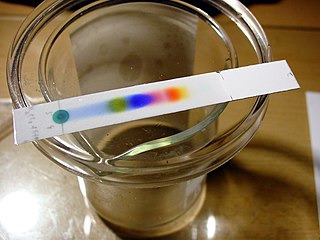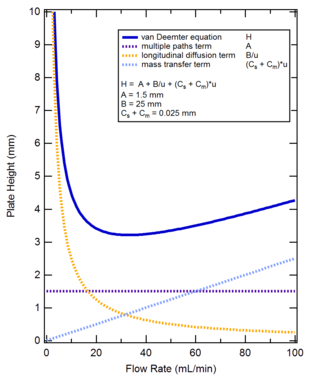General definition
In chromatography, the retardation factor, R, is the fraction of the sample in the mobile phase at equilibrium, defined as: [1]
In chromatography, the retardation factor (R) is the fraction of an analyte in the mobile phase of a chromatographic system. [1] In planar chromatography in particular, the retardation factor RF is defined as the ratio of the distance traveled by the center of a spot to the distance traveled by the solvent front. [2] Ideally, the values for RF are equivalent to the R values used in column chromatography. [2]
Although the term retention factor is sometimes used synonymously with retardation factor in regard to planar chromatography the term is not defined in this context. However, in column chromatography, the retention factor or capacity factor (k) is defined as the ratio of time an analyte is retained in the stationary phase to the time it is retained in the mobile phase, [3] which is inversely proportional to the retardation factor.
In chromatography, the retardation factor, R, is the fraction of the sample in the mobile phase at equilibrium, defined as: [1]
The retardation factor, RF, is commonly used in paper chromatography and thin layer chromatography for analyzing and comparing different substances. It can be mathematically described by the following ratio: [2]
An RF value will always be in the range 0 to 1; if the substance moves, it can only move in the direction of the solvent flow, and cannot move faster than the solvent. For example, if particular substance in an unknown mixture travels 2.5 cm and the solvent front travels 5.0 cm, the retardation factor would be 0.50. One can choose a mobile phase with different characteristics (particularly polarity) in order to control how far the substance being investigated migrates.
An RF value is characteristic for any given compound (provided that the same stationary and mobile phases are used). It can provide corroborative evidence as to the identity of a compound. If the identity of a compound is suspected but not yet proven, an authentic sample of the compound, or standard, is spotted and run on a TLC plate side by side (or on top of each other) with the compound in question. Note that this identity check must be performed on a single plate, because it is difficult to duplicate all the factors which influence RF exactly from experiment to experiment.
In terms of retention factor (k), retardation factor (R) is defined as follows:
and conversely:
In chemistry, concentration is the abundance of a constituent divided by the total volume of a mixture. Several types of mathematical description can be distinguished: mass concentration, molar concentration, number concentration, and volume concentration. The concentration can refer to any kind of chemical mixture, but most frequently refers to solutes and solvents in solutions. The molar (amount) concentration has variants, such as normal concentration and osmotic concentration.
In chemical thermodynamics, activity is a measure of the "effective concentration" of a species in a mixture, in the sense that the species' chemical potential depends on the activity of a real solution in the same way that it would depend on concentration for an ideal solution. The term "activity" in this sense was coined by the American chemist Gilbert N. Lewis in 1907.

Physical properties of materials and systems can often be categorized as being either intensive or extensive, according to how the property changes when the size of the system changes. According to IUPAC, an intensive quantity is one whose magnitude is independent of the size of the system, whereas an extensive quantity is one whose magnitude is additive for subsystems.
In chemistry, a mixture is a material made up of two or more different chemical substances which are not chemically bonded. A mixture is the physical combination of two or more substances in which the identities are retained and are mixed in the form of solutions, suspensions and colloids.

In physics and engineering, in particular fluid dynamics, the volumetric flow rate is the volume of fluid which passes per unit time; usually it is represented by the symbol Q. It contrasts with mass flow rate, which is the other main type of fluid flow rate. In most contexts a mention of rate of fluid flow is likely to refer to the volumetric rate. In hydrometry, the volumetric flow rate is known as discharge.

Paper chromatography is an analytical method used to separate coloured chemicals or substances. It is now primarily used as a teaching tool, having been replaced in the laboratory by other chromatography methods such as thin-layer chromatography (TLC).
In physical organic chemistry, a free-energy relationship or Gibbs energy relation relates the logarithm of a reaction rate constant or equilibrium constant for one series of chemical reactions with the logarithm of the rate or equilibrium constant for a related series of reactions. Free energy relationships establish the extent at which bond formation and breakage happen in the transition state of a reaction, and in combination with kinetic isotope experiments a reaction mechanism can be determined. Free energy relationships are often used to calculate equilibrium constants since they are experimentally difficult to determine.

Thin-layer chromatography (TLC) is a chromatography technique used to separate non-volatile mixtures.

The van Deemter equation in chromatography, named for Jan van Deemter, relates the variance per unit length of a separation column to the linear mobile phase velocity by considering physical, kinetic, and thermodynamic properties of a separation. These properties include pathways within the column, diffusion, and mass transfer kinetics between stationary and mobile phases. In liquid chromatography, the mobile phase velocity is taken as the exit velocity, that is, the ratio of the flow rate in ml/second to the cross-sectional area of the ‘column-exit flow path.’ For a packed column, the cross-sectional area of the column exit flow path is usually taken as 0.6 times the cross-sectional area of the column. Alternatively, the linear velocity can be taken as the ratio of the column length to the dead time. If the mobile phase is a gas, then the pressure correction must be applied. The variance per unit length of the column is taken as the ratio of the column length to the column efficiency in theoretical plates. The van Deemter equation is a hyperbolic function that predicts that there is an optimum velocity at which there will be the minimum variance per unit column length and, thence, a maximum efficiency. The van Deemter equation was the result of the first application of rate theory to the chromatography elution process.
Gas phase ion chemistry is a field of science encompassed within both chemistry and physics. It is the science that studies ions and molecules in the gas phase, most often enabled by some form of mass spectrometry. By far the most important applications for this science is in studying the thermodynamics and kinetics of reactions. For example, one application is in studying the thermodynamics of the solvation of ions. Ions with small solvation spheres of 1, 2, 3... solvent molecules can be studied in the gas phase and then extrapolated to bulk solution.
The distribution constant (KD) is the equilibrium constant for the distribution of an analyte in two immiscible solvents.
An internal standard in analytical chemistry is a chemical substance that is added in a constant amount to samples, the blank and calibration standards in a chemical analysis. This substance can then be used for calibration by plotting the ratio of the analyte signal to the internal standard signal as a function of the analyte concentration of the standards. This is done to correct for the loss of analyte during sample preparation or sample inlet. The internal standard is a compound that is very similar, but not identical to the chemical species of interest in the samples, as the effects of sample preparation should, relative to the amount of each species, be the same for the signal from the internal standard as for the signal(s) from the species of interest in the ideal case. Adding known quantities of analyte(s) of interest is a distinct technique called standard addition, which is performed to correct for matrix effects.
A mass chromatogram is a representation of mass spectrometry data as a chromatogram, where the x-axis represents time and the y-axis represents signal intensity. The source data contains mass information; however, it is not graphically represented in a mass chromatogram in favor of visualizing signal intensity versus time. The most common use of this data representation is when mass spectrometry is used in conjunction with some form of chromatography, such as in liquid chromatography–mass spectrometry or gas chromatography–mass spectrometry. In this case, the x-axis represents retention time, analogous to any other chromatogram. The y-axis represents signal intensity or relative signal intensity. There are many different types of metrics that this intensity may represent, depending on what information is extracted from each mass spectrum.
Reversed-phase chromatography includes any chromatographic method that uses a hydrophobic stationary phase. RPC refers to liquid chromatography.
In gas chromatography, the Kovats retention index is used to convert retention times into system-independent constants. The index is named after the Hungarian-born Swiss chemist Ervin Kováts, who outlined the concept in the 1950s while performing research into the composition of the essential oils.
In chemical analysis, matrix refers to the components of a sample other than the analyte of interest. The matrix can have a considerable effect on the way the analysis is conducted and the quality of the results are obtained; such effects are called matrix effects. For example, the ionic strength of the solution can have an effect on the activity coefficients of the analytes. The most common approach for accounting for matrix effects is to build a calibration curve using standard samples with known analyte concentration and which try to approximate the matrix of the sample as much as possible. This is especially important for solid samples where there is a strong matrix influence. In cases with complex or unknown matrices, the standard addition method can be used. In this technique, the response of the sample is measured and recorded, for example, using an electrode selective for the analyte. Then, a small volume of standard solution is added and the response is measured again. Ideally, the standard addition should increase the analyte concentration by a factor of 1.5 to 3, and several additions should be averaged. The volume of standard solution should be small enough to disturb the matrix as little as possible.
Charge transfer coefficient, and symmetry factor are two related parameters used in description of the kinetics of electrochemical reactions. They appear in the Butler–Volmer equation and related expressions.
Binding selectivity is defined with respect to the binding of ligands to a substrate forming a complex. Binding selectivity describes how a ligand may bind more preferentially to one receptor than another. A selectivity coefficient is the equilibrium constant for the reaction of displacement by one ligand of another ligand in a complex with the substrate. Binding selectivity is of major importance in biochemistry and in chemical separation processes.
A descriptor is in chemical nomenclature a prefix placed before the systematic substance name, which describes the configuration or the stereochemistry of the molecule. Some listed descriptors are only of historical interest and should not be used in publications anymore as they do not correspond with the modern recommendations of the IUPAC. Stereodescriptors are often used in combination with locants to clearly identify a chemical structure unambiguously.

In chromatography, resolution is a measure of the separation of two peaks of different retention time t in a chromatogram.